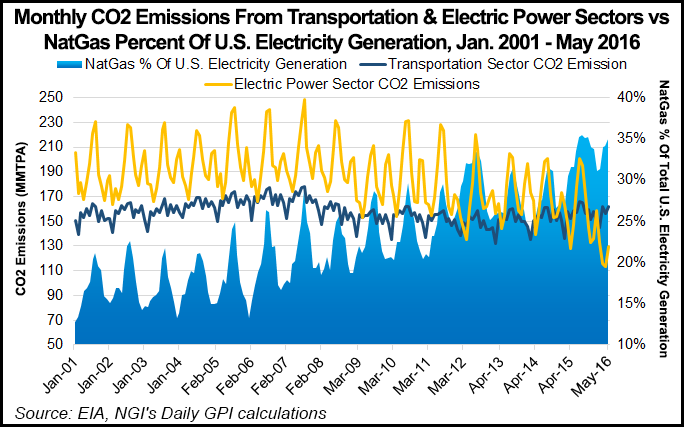Regulatory | E&P | NGI All News Access
Analysis Shows NatGas Driving Power Sector CO2 Emissions Below Transportation
Thanks in large part to coal-to-gas switching, yearly carbon dioxide (CO2) emissions from the power sector will likely fall below CO2 emitted from transportation for the first time in nearly 40 years, according to a technical brief published this month by the University of Michigan Energy Institute.

The average rate of CO2 emissions from vehicles and other mobile sources has surpassed the rate of CO2 emitted from power plants for seven of the last eight months for which data is available, according to the brief, authored by research professor John M. DeCicco.
CO2 from the power sector has exceeded CO2 from transportation every year since 1979, with both peaking in 2007 before the recession. Since then, power sector emissions have declined on average by 2.8%/year. Meanwhile, transportation emissions have increased by an average 1.8% annually over the last four years as the economic recovery has sparked growth in transportation fuel demand, according to DeCicco.
“For power generation, the shift away from coal enabled CO2 emissions to fall even though there was little net change in how much electricity the nation consumed. From 2007 to 2015, U.S. electricity consumption fell just 0.7%, but the sector’s CO2 emissions dropped 20%,” DeCicco wrote. “During this time, the share of electricity generated by coal fell from 50% to 34% while shares rose from 20% to 32% for natural gas, from 0.9% to 4.9% for wind and from 0.02% to 0.66% for solar; the nuclear portion of power production held steady at around 20%.”
Even with pending data on the summer months likely to show a seasonal bump in electricity demand, “barring a large and sustained increase in petroleum prices” the trend lines point to transportation emissions of CO2 topping the power sector in 2016, DeCicco wrote.
The Environmental Protection Agency’s Clean Power Plan, if implemented, would see the downward trend in power sector CO2 emissions continue, “widening the gap by which transportation exceeds electricity in the years ahead unless additional steps are taken to reduce or offset the CO2 emitted by cars, trucks, aircraft and other mobile sources,” DeCicco wrote.
© 2024 Natural Gas Intelligence. All rights reserved.
ISSN © 1532-1231 | ISSN © 2577-9877 |
